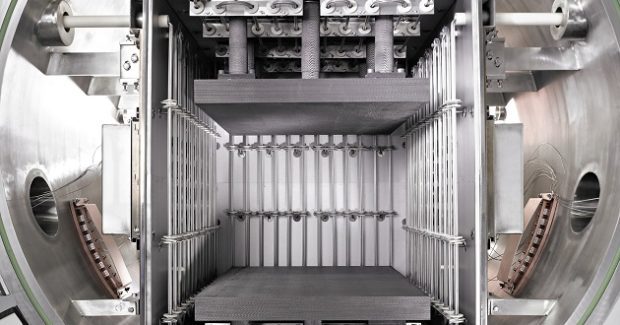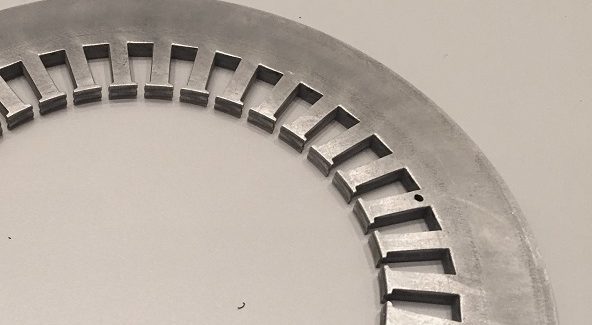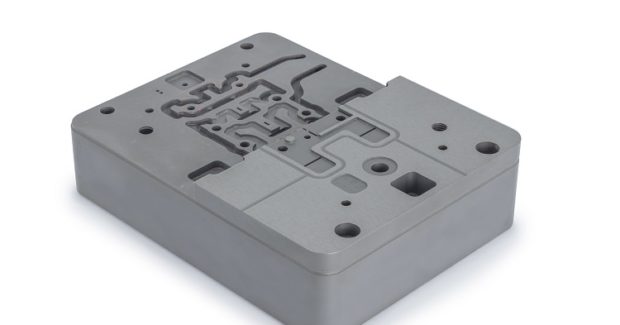Another Way to Build Complex Parts with Dissimilar Metals
Laminated object manufacturing uses diffusion bonding to fuse thin layers of similar or dissimilar metals together and build complex metal parts with internal passageways for conformal cooling, heat exchangers, liquid/gas dispensing and other difficult applications.
Posted: July 9, 2019
Laminated object manufacturing (LOM) is a unique additive manufacturing process that can help precision machine shops create metal parts with complex internal cooling passageways or channels for dispensing liquids or gas layer-by-layer before final machining. LOM can be used to build a part from the ground up with thin 1 mm to 2 mm sheets of metals and alloys, using 3D modeling software to map out the sophisticated internal channels or passageways prior to CO2 laser cutting of each layer. The key to LOM is diffusion bonding, which essentially fuses the combined layers together under pressure and heat, without the need of brazing or other filler material. Traditional machining is then used to bring the exterior of the part to its final shape. Using LOM, finished parts as large as 900 mm (35.43 in) x 1,250 mm (49.21 in) x 500 mm (19.69 in) can be constructed from stainless steel, titanium, zirconium, beryllium, high-alloyed aluminum, Inconel and tungsten. This process can also be used to weld dissimilar metals like copper to titanium, copper to aluminum, copper to tungsten and even Molybdenum to aluminum.
For precision machine shops serving the medical, aerospace, semiconductor and automotive industries, LOM can create parts that are difficult, if not impossible, using traditional CNC equipment or less effective brazing/welding techniques. For metal parts that require sophisticated internal channel geometries, whether with an inlet and outlet – or neither – there can be many twists and turns. Examples include heat exchange applications, where channels are machined into aluminum to disperse heat by air or liquid cooling. Given that the surface area of the cooling zone is a primary factor in heat transfer, the more extensive the channels, the better. Conformal cooling channels can also increase the efficiency and cycle times of plastic injection molds. These cooling passageways follow the shape or profile of the mold core or cavity to perform a rapid uniform cooling process for injection and blow molding.
Other applications include liquid and gas dispensing equipment. For example, semiconductor and microelectronics fabrication uses sophisticated showerhead-style gas distribution assemblies to dispense processing gases into a semiconductor etching and deposition chambers. These dispensing heads often have multiple, separate internal passageways. Traditional CNC cutting tools cannot be used to make these, but one alternative being used for showerhead assemblies is a similar additive process that varies in how it joins the layers: with brazing material. Brazing joins two or more metal items together by melting and flowing a filler metal into the joint. The filler metal flows into the gap between the layers through capillary action. Although brazing can join similar or dissimilar metals with considerable strength, it also has significant drawbacks when internal passageways are involved: it can cause small “fillets” to form in the passageways that obstruct flow and can even break off during use. Too little brazing material can create voids where liquid or gas accumulates and corrosion sets in, particularly in the presence of harsh chemicals like those used in the semiconductor industry. The result can be delamination of the layers and premature replacement of what can be extremely expensive parts made out of exotic materials.
Compare this to diffusion bonding, which creates a superior bond without the need of any type of filler material. In this process, high temperature and pressure are applied to similar or dissimilar metals in a hot press, causing the atoms on solid metallic surfaces to intersperse and bond. Unlike traditional brazing techniques, the resulting bond exhibits the strength and temperature resistance of the base metals. For the atoms of two solid, metallic surfaces to intersperse, they typically must be at approximately 50 percent to 70 percent of the absolute melting temperature of the materials. To achieve these temperatures, the surfaces are heated either in a furnace or by electrical resistance to temperatures as high as 1,400 deg C. Diffusion bonding has long been used to join high strength and refractory metals that are either difficult or impossible to weld by other means. However, it was only through recent improvements in diffusion bonding presses that this new process has become even more attractive. This includes improvements to single-cylinder hydraulic presses that required fixtures to apply a consistent, measurable amount of force – a key factor in the process.
PVA TePla America (Corona, California) offers multi-cylinder systems with large pressing plates that can accommodate a variety of parts. The largest is their MOV 853 HP that can process parts as big as 900 mm x 1,250 mm at a pressing force of 4,000 kN. By controlling each cylinder independently, companies like PVA TePla can provide a press that provides extremely consistent pressure across the entire surface. The MOV 853 comes with built-in pressure transducers along the bottom of the pressing plate that allow individual hydraulic cylinders to be adjusted to achieve superior pressure uniformity over large areas. In addition to selling the equipment, PVA TePla can also create diffusion bonded parts using this technique through toll processing services offered by its parent company in Germany.
One of the most appealing aspects of diffusion bonding is its ability to not only create the internal structures, but also to join layers of dissimilar metals. There is no restriction on materials since all tooling steels are available in bulk sheets. “Customers often want to bond aluminum to molybdenum or stainless steel,” said Walt Roloson, the R&D engineering manager at PVA TePla. “We are able to do that with diffusion bonding.” The multi-layer approach also improves conformal cooling of plastic injection molds made in two-layer designs of tool steel and material such as stainless steel (STAVAX). “For the most efficient performance, conformal cooling channels should be adapted as precisely as possible to the outer shape of the mold,” explained Roloson. “The higher the number of layers bonded together, the more precisely it can match the outer shape.” By improving cooling performance, melted resins can be injected at higher pressures to significantly increases cycle times as much as 40 percent while enhancing product quality.
Once the layers are bonded together by diffusion bonding, traditional machining techniques are used to create the final external shape. “Due to the molecular bonding of the layers, the final part often shows no interface lines or striations,” noted Roloson. “The interface of one material is actually blended into the other one and vice versa, even with dissimilar materials.” Although LOM with diffusion bonding is targeted at specialized applications, it may be a perfect complement for precision machine shops that already have in-house laser cutting and machining capabilities and are looking to diversify their offerings.
PVA TePla America, 251 Corporate Terrace, Corona, CA 92879-6000, 951-371-2500¸ Fax: 951-346-3232, www.pvateplaamerica.com.

















